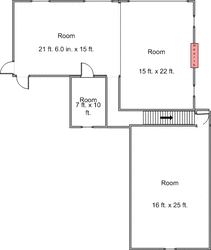vgrund said:
I have been thinking about wood stoves and smoke detectors. It seems to me this could be a Goldilocks situation (not too near, not too far). My house, as constructed, does not have a smoke detector in the kitchen or family room (they connect in an open floor plan). I'm sure the idea at the time was to avoid false alarms from cooking (there is a smoke detector on that floor, way on the other side of the house and not in the area the diagram below). I'm planning to put an insert in the family room fireplace. Where do you have your nearest smoke detector?
Victor
Hi there . . . newbie here . . . well kind of, sort of. I've been lurking here for several days . . . and in the process realized that some of my on-line friends (aka Flying Cow) from other sites and neighbors (folks in Unity, Bangor and Waterville -- where I do most of my shopping) are here as well . . . so I figured I might as well join and contribute when and where possible and since fire safety is well . . . my specialty . . . figured I might as well make a comment or two to this thread.
Oh yeah, I also grew up with my parents using a hot air wood furnace in the 1970s/1980s and when I graduated from college I lived in a small camp that primarily used a woodstove for heat (early 1990s). The wood furnace provided good heat, but it was old tech and of course used a lot of wood (10-12 cords each year) to get us through the winter. The woodstove was also nice . . . but definitely over-sized for the space (it was free) . . . I ended up cooking my goldfish one day and it was not unusual for me to have every window in the place open in middle of a January snowstorm.
In any case I'm just like most other folks right now who are researching their options and getting ready to make a purchase as the price of oil skyrockets (my oil company isn't even providing a locked in price this year for their budget plan -- just stating that they will deliver oil for 5 cents below the daily cash price) . . . plus honestly I've wanted a back-up heating source in my house for some time now.
While I would love to go with an indoor gassification wood boiler down the road, at this stage of the game I'm leaning more towards a woodstove.
OK, that said . . .
In answer to your question . . . as you mentioned, positioning a smoke detector for best use can be a Goldlilocks moment . . . not too close and not too far. As mentioned by others the Life Safety Code 101 adopted by virtually every State requires smoke detectors on every level of the home (including the basement), in hallways outside sleeping areas and in sleeping areas. Those are the basics . . . it usually doesn't hurt to add in more smoke detectors . . . but there are some bad areas in the home (i.e. kitchen, laundry rooms, bathrooms, un-used attics and . . . too close to a woodstove, fireplace, etc.)
What I personally will be doing in my home is installing a smoke detector in the hall which leads to the room with the fire appliance. If there are too many false alarms I will be moving the detector a few more feet away. In either case I will be using one of the newer models that has a hush/silence feature . . . a lot of folks are unaware of these types of detectors . . . in the advent of a false alarm you can simply depress the silencer feature and the alarm will silence itself for five minutes allowing you to clear the room of the smoke, steam, burned toast, etc. After five minutes the detector resets itself -- acting as though you pulled the battery out and then put it back in . . . the only thing is you don't forget to do so . . . all automatic. These detectors can be purchased with 9-volt batteries, a 10-year lithium battery power or you can connect with AC power if your home is so equipped. A new (about 4 years old now) detector is now being sold that uses your TV remote (or stereo remote, DVD remote, etc.) to silence the detector (ideal for cathedral ceilings or high ceilings where it would be a challenge to hit the silence button.) Most of these detectors chirp every every half a minute to let you know that the detector has been silenced . . . and if the smoke/steam/etc. continues to build in the area the detector will go back into the alarm mode.
I hope this may help.




 . Between chimney fires and a grease fire in the past few years that's enough excitement for a lifetime!
. Between chimney fires and a grease fire in the past few years that's enough excitement for a lifetime! ). A lot of folks don't realize that they should replace their aging detectors . . . they know to change the battery . . . but don't know about changing the entire detector.
). A lot of folks don't realize that they should replace their aging detectors . . . they know to change the battery . . . but don't know about changing the entire detector.